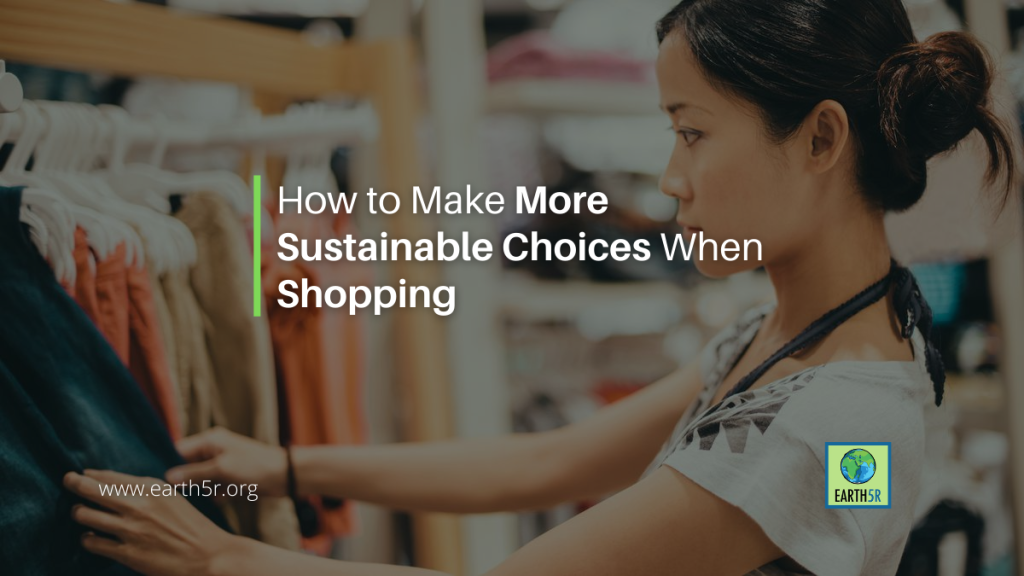
How To Make More Sustainable Choices When Shopping
1. Ditch Single-Use Bags And Bottles.
Plastic pollution is one of the most significant contributors to the global waste epidemic. When you consider that Our World in Data estimates 381 million tons of plastic were produced in 2015, it’s no surprise that this amount — the equivalent to roughly two-thirds of the world population — is wreaking havoc on the health of global wildlife and our planet’s oceans and marine life.
The good news is that reusable is becoming a much more common personal choice and is also being mandated by municipalities around the globe through plastic bag bans and more.
2. Learn About Ethical Fashion.
While the fashion industry has been the target of intense scrutiny by sustainability advocates, examples of sustainable living can be found. It’s important to remember truly sustainable fashion (also called “ethical” or “slow” fashion) takes into account an item’s full life cycle, including sourcing, shipping, and end of life, as well as the people and resources it affects.
Our pros suggest buying secondhand whenever possible (and selling your unwanted clothes online). Since the ultimate goal is to produce less and use things longer, the most sustainable fashion is anything pre-owned.
3. Buy From Truly Sustainable Brands And Companies.
“Corporate sustainability is thought to have three pillars: people, planet, and profit,” says Aral. “For any business, ensuring the health of employees (and people related to that business) and minimizing or even reversing its environmental impacts should be just as important as turning a profit, for it to be sustainable in the long run.”
So do your research when seeking products and brands committed to sustainable practice by looking for brands that promote specific sustainable practices, including reducing water and hazardous chemicals used in production or using recycled materials or sustainable fibers such as organic cotton. You can also look for sustainable and recycled materials and trusted third-party emblems like EcoCert Cosmos for organic cosmetics, Fair Trade Certified ingredients, or GreenGuard Certified products.
Fast Fashion Is Cheap, Trendy, And Destructive—It’s Time To Slow It Down.
What Is Fast Fashion? – Earth5R
4. Shop Organic When You Can.
Opting for organic clothing and bedding is an excellent step toward sustainability. Why? “GOTS certified organic fabrics follow strict environmental standards throughout the entire production process,” according to GH Institute Textiles Director Lexie Sachs. “For starters, organic cotton and other natural fibers are grown using less water and without pesticides and other potentially harmful treatments. Then the rest of the manufacturing steps – from the dyes and finishes to the factory’s ethical conditions – must also comply with specific criteria.”
5. Look For Sustainable Packaging.
Packaging is generally defined as the products used to wrap or protect goods, including food and drink and home and personal care items. It covers everything from culinary containers and detergent bottles to packaging for beauty products and all those delivery boxes. According to the United States Environmental Protection Agency or EPA, over 80 million tons of packaging waste end up in U.S. landfills every year. In Europe, packaging waste is estimated at 77.8 million tons annually.
Choosing sustainable packaging is one way to offset the massive waste in landfills. But sustainable packaging can also help the planet in other, less expected ways. For example, a moisturizer with less packaging is lighter to transport, which means fewer greenhouse gases are released on its journey from the manufacturing facility to its final destination in your bathroom. That’s also why the experts in the Good Housekeeping Institute introduced our Sustainable Packaging and Sustainable Innovation Awards, which recognize products that use minimal packaging materials and practices.
The consumer pattern is encouraging globally, as two-thirds of buyers are willing to spend more on eco-friendly clothes.
Eco-friendly Fashion: India’s Sustainable Apparel Market is Finding More Takers – Earth5R
Buy Less And Save Water
Apparel Production Accounts For 10% Of Worldwide Carbon Emissions.
Manufacturing new products are energy and resource-intensive process.
The amount of water consumed and polluted in the processing stages of a product – called its Water Footprint or virtual water – is a looming threat our world can not afford in the face of dire water scarcity experienced by billions worldwide every year.
A Single Cotton T-Shirt Requires Over 2500 Liters Of Water.
And the carbon emissions during production are 12 times more than the t-shirt’s own weight.
Add to this the shipping emissions from importing or outsourcing items, and you have a recipe for environmental destruction.
1.1 billion people worldwide lack access to water
In a world with increasing consumerist instinct where the product you desire is a click away, one needs to understand the impact of this single click.
Be a responsible buyer,
- Realize wants are different from needs.
- Repair what you have.
- Opt for resale, refurbished, or thrift options.
To read more of such articles, please visit https://earth5r.org/
Source: What Is Sustainability? A Sustainable Living Guide for Beginners (goodhousekeeping.com)




